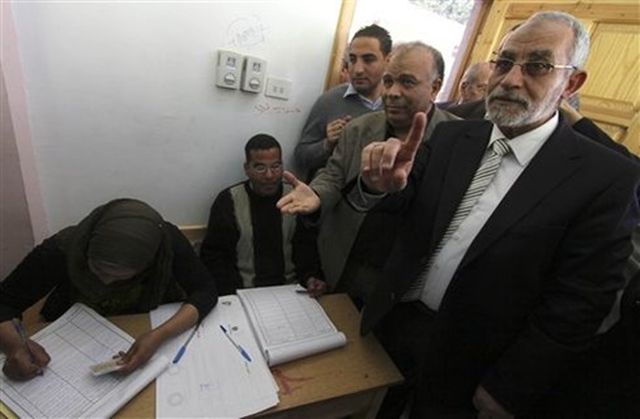
After Mubarak: Egypt’s Islamists Struggle to Adapt to the Egyptian Revolution
After Mubarak: Egypt’s Islamists Struggle to Adapt to the Egyptian Revolution
Following the departure of Egyptian president Hosni Mubarak on February 11 and the collapse of his regime, new faces and conflicts have appeared within the ranks of Egypt’s Islamist movement, including the Muslim Brotherhood.
As with the larger Egyptian revolution, internal dissent first appeared on Facebook pages under the slogan “Brotherhood, Development, Revolution.” Postings from the Brotherhood youth called for the dissolution of the various group structures, including the post of the General Guide, the Guidance Office and the Consultative Council, as well as demanding the involvement of the younger members and the “Sisters division” in the Brotherhood’s decision. In addition, the Facebook pages demanded the assignment of a committee of five members (with relevant qualifications and who are not members of the current Guidance Office) to manage the Group’s affairs during the transition phase in the run-up to elections in six months.
This reveals a possible cloning for the Egyptian revolution within the Muslim Brotherhood, whereby the group’s youths threatened to take to the streets and hold protests demanding the dissolution of the organization if their demands were not met by March 11. These threats compelled the group’s Guide, along with a number of its leaders, to meet with the youth’s leadership (comprised of 200 members) in Cairo for four full hours in order to ease their anger and pledge to respond to their demands (IslamTimes.org, March 3).
The situation looks more difficult for the Egyptian Islamic Group (EIG), which appears to have joined the revolution only after it had achieved its objective. The EIG leadership adopted a stance contrary to the revolution at its onset and took little part in it. While the EIG prepares to establish an Islamic Party, as announced by one of its leaders, heated discussions are going on within its youth wing over the movement’s role in the revolution. Many of the group’s youth resent their leaders’ attitudes toward the revolution as well as their hesitant and indecisive reaction to the momentous developments.
This dispute reveals a severe generational conflict within the group that threatens to divide it and disperse its members. Historically, the EIG leaders have been the sole decision makers within the movement. It is possible that some of its youth members might choose to join new Islamic parties that include senior jihadists and independent Islamists.
In Alexandria the Salafists were not enthusiastic about the revolution from the start. Their members did not join it in practice and confronted it in theory. The Salafists repeatedly claimed that involvement in the uprisings and political conflicts would divert attention away from preaching activities and would further exhaust the Islamic movement.
After the success of the revolution many Facebook invitations were sent to the Salafists to work in politics and help unify the Islamic movement. However, the Salafists insisted on adhering to their commitment to preaching activities and refusing to take part in political work. Despite their opposition to political participation, the Salafists have issued a number of announcements in which they confirmed the necessity of fully activating the second article of the Egyptian constitution (providing that Shari’a will be the main source of legislation) by implementing Islamic law
In an interview with the Egyptian newspaper Al Shorouq, Salafist advocate Ahmad Farid confirmed that members of the Salafist movement did not take part in the revolution or its protests, which required forbidden things like mixing between men and women and the raising of the Cross. Despite their view of democracy as blasphemy, Farid did not dismiss the idea of the Salafists being active within a political party: “The Salafists must be present in the political arena in the coming phase and it’s not unlikely that the movement would endorse specific individuals to take part in general elections, either parliamentary or presidential, especially after the collapse of the fear barrier which preyed on the previous era [i.e. Mubarak’s regime]… The Street seeks the Salafists who would hold the Islamic rituals and would provide more public services than the brotherhood” (Shorouk News, March 5).
The Salafists were invited to join in on political work by other streams as well, including the Salafist “Hafs” movement headed by Shaykh Rida Ahmad al-Samady. [1] Some recent leaks point to the possibility of the Salafists approving of their youth joining one of the Islamic parties that are being formed after the revolution and will call for the full implementation of Islamic law in accordance with a Salafist process. This is a major change from pre-revolution days when the leadership rejected a similar invitation from al-Samady.
The Salafists have observed that their persistent calls for the full activation of the second article of the Egyptian constitution prompted both the head of Cairo’s al-Azhar University and Coptic Pope Shenouda III to request that it remain unchanged in its current application. Other requests for the establishment of a civil democratic state are considered completely taboo by the Salafists, as this threatens their Islamic vision of the Egyptian state (Shorouk News, March 5).
Notes:
1. https://alharakahalsalafiah.blogspot.com/ , March 14, 2011.


